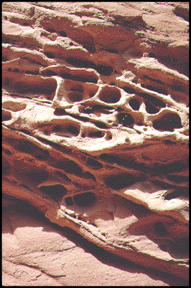 | "To understand what sedimentary rocks are made of, the processes that lead to their formation must be understood!" |
|
 | "I'm willing to go there, Lulu! |
|
 | "Good man, Lou! The recipe for sedimentary rocks is: - Weather a pre-existing rock to make sediment.
- Transport and deposit the sediment.*
- Turn the sediment into rock (lithify the sediment).
Each of these steps plays a part in determining the composition of the sedimentary rock! Let's learn about or review each of the steps!" *Actually, in a small number of cases, step 2 is omitted. The weathered materials stays where it is and turns into rock. |
|
|
|
| TRANSPORT AND DEPOSITION OF SEDIMENT |
Once it is produced by weathering, sediment may be transported from its place of origin. - Sediment may gradually or rapidly work its way downslope due to the pull of gravity.
- Sediment may be picked up and carried by 'agents of transport': streams, wind, flowing ice, tides, waves, or living organisms.
- When the ground becomes level or agents of transport lose their energy, the sediment comes to rest (is deposited).
- Transport and deposition may occur repeatedly until the sediment comes to its 'final' resting place, where it is turned into rock.
|
 |
| REVIEW SOME OF THE WAYS IN WHICH SEDIMENT MAY BE TRANSPORTED AND DEPOSITED |
 |
BY FLOWING ICE AND MELTWATER |
 |
BY LANDSLIDES |
 |
BY FLOWING WATER |
| EXAMINE WHAT HAPPENS TO SEDIMENT DURING TRANSPORT |
 | THE EVOLUTION OF SEDIMENT |
 List three ways in which the sediment changed during transport. List three ways in which the sediment changed during transport.
|
| TRANSPORT AND DEPOSITION OF DISSOLVED MINERAL MATTER |
 | THE FATE OF DISSOLVED MINERAL MATTER |
|
|
| LITHIFICATION OF SEDIMENT |
| Once sediment comes to rest, it may be turned into rock. Lithification is most likely if a great thickness of sediment accumulates. The sediment grains that are buried are protected from being picked up and moved some more, and so have a chance to become attached to one another. As you have learned, the attachment is accomplished by cementation or by grains growing until they interlock. |
 |
| REVIEW SOME OF THE WAYS IN WHICH SEDIMENT GRAINS MAY BECOME ATTACHED TO ONE ANOTHER |
 |
BY INTERLOCKING GRAINS |
 |
BY CEMENTATION |
| Sediment accumulates and and has the chance to turn into rock in diverse locations on land and the floors of lakes and oceans. These locations will be described |
|
|
 | "So, Lou, what do you think?! Can sedimentary rocks be identified as such on the basis of the minerals they contain?! I'll provide some help in the form of some questions!" |
|
 | "As always, you're a great help! OK, serve me up the questions!! |
|
 Here are six questions that will help you decide if the mineralogy of a rock can provide clues as to whether it is sedimentary in origin. A distinction will be made between sediment that is 'fragmental' (composed of broken pieces of rock) and sediment that is 'precipitated' (composed of material precipitated from solution). Here are six questions that will help you decide if the mineralogy of a rock can provide clues as to whether it is sedimentary in origin. A distinction will be made between sediment that is 'fragmental' (composed of broken pieces of rock) and sediment that is 'precipitated' (composed of material precipitated from solution).
|
To check your answers and get additional hints and information, click on the link. |
 Here are six questions that will help you decide if the mineralogy of a rock can provide clues as to whether it is sedimentary in origin. A distinction will be made between sediment that is 'fragmental' (composed of broken pieces of rock) and sediment that is 'precipitated' (composed of material precipitated from solution).
Here are six questions that will help you decide if the mineralogy of a rock can provide clues as to whether it is sedimentary in origin. A distinction will be made between sediment that is 'fragmental' (composed of broken pieces of rock) and sediment that is 'precipitated' (composed of material precipitated from solution).




